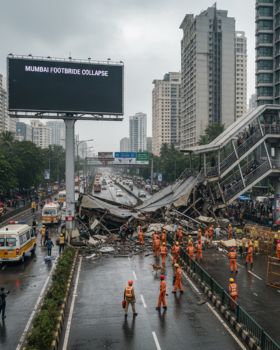
Disclaimer
This article is for informational purposes only and should not be considered legal, engineering, or professional safety advice. Organizations should consult qualified professionals and official guidelines before implementing any safety measures or technologies.
In April 2018, a tragic incident occurred at the KOZK 1,891-foot communication tower in Fordland, Missouri. During structural modifications aimed at reinforcing the tower for transmission line upgrades, the unthinkable happened: the tower collapsed. The resulting disaster not only led to the loss of valuable infrastructure but also served as a painful reminder of the importance of rigorous safety protocols and meticulous planning when it comes to contractor management and work permit processes.
This collapse wasn’t an isolated incident. It is part of a larger issue that has repeatedly demonstrated the risks inherent in poorly managed contractor operations, insufficient structural assessments, and inadequate work permit management. In this blog, we will dive deep into the key issues that led to the collapse and discuss how businesses can avoid similar disasters. We’ll explore the lessons learned from the 2018 communication tower collapse and explain how the best contractor management software, contractor management solutions, work permit management software, work permit software, and work permit management can ensure safety, compliance, and the successful completion of high-risk projects.
The KOZK Tower Collapse: What Went Wrong?
Before exploring the solutions, it’s essential to understand what led to the tower’s catastrophic failure. The collapse was the result of several intertwined issues that compromised the structural integrity of the communication tower during modifications. Here’s a breakdown of the key issues that contributed to the disaster:
- Flawed Modification Procedures
The primary cause of the tower’s collapse was flawed modification procedures. The work involved replacing the diagonal braces to reinforce the structure and facilitate upgrades to the transmission lines. Unfortunately, the procedure weakened the surrounding braces, compromising the load-bearing capacity of the tower’s legs. This led to a catastrophic failure that could have been prevented if a more thorough evaluation and testing of the structural modifications had been conducted before any work began.
Lesson: All structural modifications should undergo a detailed assessment to ensure they will not inadvertently weaken the overall integrity of the structure. It’s critical to adopt a comprehensive approach to evaluating modifications, factoring in the full impact on the load-bearing capacity of the structure, and ensuring all changes are fully tested.
- Risk of Overloading
The structural modifications overlooked how changes to one part of the tower could affect the overall load distribution. By altering critical elements like braces and legs, the team inadvertently disrupted the balance of the load, leading to an overload in certain sections. This resulted in the collapse, which was further exacerbated by poor risk assessment and inadequate monitoring during the modification process.
Lesson: Any changes made to a structure must account for how those changes will affect the overall load distribution. Tall, complex structures, especially those like communication towers, require comprehensive structural assessments that consider the interrelatedness of all components. Failure to do so can lead to unforeseen consequences.
- Contractor Responsibility and Compliance
At the time of the collapse, the contractor was performing the structural modifications. The incident underscored the importance of ensuring that contractors meet safety and quality standards, and that they adhere to all safety protocols. There were clear signs that the contractor failed to properly evaluate the work, either because of a lack of experience, insufficient oversight, or poorly communicated expectations between the project managers and contractors.
Lesson: Contractors must be held accountable for their actions. Ensuring that contractors comply with all relevant safety protocols, perform proper evaluations, and adhere to the project’s structural requirements is crucial. Both project managers and contractors must collaborate closely to ensure safety and compliance at every stage of a project.
The Role of Technology in Preventing Disasters
While the collapse of the KOZK communication tower was tragic, it also provides a vital learning opportunity. The good news is that businesses can now leverage modern technology to avoid such risks and ensure the safety of their projects. The right tools and systems—such as the best contractor management software, contractor management solutions, work permit management software, and work permit software—can play an instrumental role in preventing similar incidents from occurring in the future.
Let’s explore how these technologies can mitigate risks and improve safety on construction and modification projects.
Best Contractor Management Software: Streamlining Safety and Compliance
Contractor management software is an essential tool for businesses that rely on contractors for high-risk projects. The best contractor management software allows organizations to vet contractors, track their compliance with safety standards, and manage their performance over time. For example, software solutions can provide a centralized platform for storing contractor certifications, safety training records, and previous performance evaluations.
This technology also allows businesses to manage the bidding process more effectively, ensuring that contractors are selected based on their ability to meet stringent safety and quality standards. A robust contractor management system will allow you to:
- Assess Contractor Compliance: Ensuring that contractors adhere to safety protocols, such as having the correct certifications or following best practices in structural modification.
- Track Performance: Reviewing past projects and contractor evaluations helps businesses select the most qualified professionals for future work.
- Document Management: Storing all necessary documents, including insurance certificates, safety plans, and contract agreements, in one place for easy access.
By using the best contractor management software, companies can reduce the risk of accidents, ensure compliance with safety regulations, and enhance the overall quality of their projects.
Contractor Management Solution: Ensuring Coordination and Oversight
A contractor management solution goes beyond just software; it involves the processes and systems that enable businesses to maintain tight oversight over contractors throughout the course of a project. Effective contractor management ensures that all procedures and safety standards are followed, reducing the likelihood of dangerous mistakes.
Key features of an effective contractor management solution include:
- Clear Communication Channels: Ensuring that all parties involved—contractors, project managers, safety officers, etc.—can communicate easily and openly.
- Regular Inspections: Frequent on-site inspections can help catch potential problems early, allowing for timely corrective actions.
- Real-time Updates: Providing real-time updates on project status, including any changes to scope or schedule, ensures that everyone is on the same page and minimizes the risk of errors.
With a well-executed contractor management solution, companies can ensure their projects stay on track, within budget, and, most importantly, meet all safety requirements.
Work Permit Management Software: A Critical Safety Tool
In high-risk environments like construction, telecommunication towers, or oil rigs, proper work permit management is vital to ensure safety and compliance. Work permit management software helps businesses control and document every aspect of work permits, including who is authorized to perform specific tasks and under what conditions.
This software streamlines the process of issuing, tracking, and closing work permits, ensuring that only qualified personnel perform dangerous tasks. Work permit management software can also automate notifications and approvals, reducing human error and improving the efficiency of safety procedures.
Key features of work permit management software include:
- Automated Work Permit Issuance: Automatically generating work permits based on predefined criteria, such as the type of work, location, and the contractor’s qualifications.
- Real-Time Notifications: Sending alerts to supervisors and safety managers when permits are about to expire or when additional documentation is required.
- Audit Trails: Maintaining a complete and accessible record of all work permits issued, including any conditions or restrictions associated with the work.
By using work permit software, companies ensure that work is being conducted according to safety standards, significantly reducing the chance of accidents like the KOZK tower collapse.
Work Permit Management: Enhancing Safety and Compliance
A comprehensive work permit management system involves more than just software—it also incorporates workflows and policies that ensure all work activities are performed safely. It involves assigning clear responsibilities, tracking the completion of safety training, and ensuring all work conditions are met before the work begins.
Work permit management can be particularly important for companies involved in high-risk activities, such as construction, maintenance, and modification of complex structures. It helps by:
- Identifying Hazards Early: Identifying potential hazards before work begins by requiring detailed risk assessments as part of the work permit approval process.
- Ensuring Qualified Personnel: Ensuring that only workers with the necessary skills and certifications are allowed to perform specific tasks.
- Enforcing Safety Standards: Ensuring that safety standards are adhered to by providing clear documentation and monitoring compliance throughout the life of the project.
Conclusion: Preventing Future Tragedies
The collapse of the KOZK communication tower in 2018 was a wake-up call for many in the construction and engineering sectors. It highlighted the critical importance of proper contractor management, safety protocols, and the need for rigorous work permit processes. By adopting the best contractor management software, implementing comprehensive contractor management solutions, and utilizing work permit management software, businesses can significantly reduce the likelihood of such disasters and ensure the safety and success of their projects.
At SHEQ Network, we are dedicated to helping businesses avoid such tragedies by providing advanced solutions like Contractor Management Portals and Work Permit Systems. These systems ensure that all procedures are thoroughly vetted, compliant with safety standards, and, ultimately, protect your projects and people.
By learning from past mistakes and implementing the right technologies and practices, we can build a safer, more efficient future for the construction and engineering industries.



